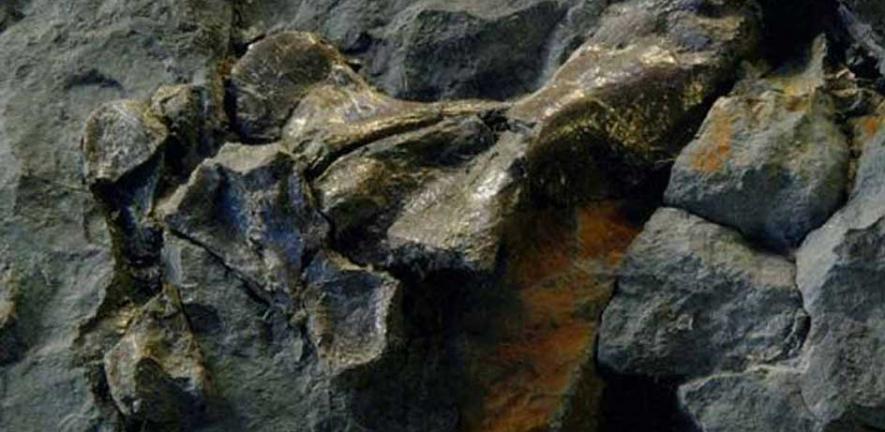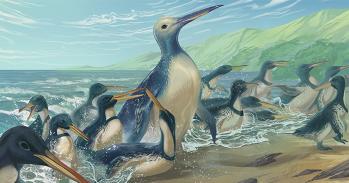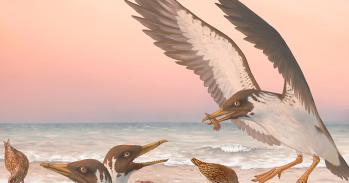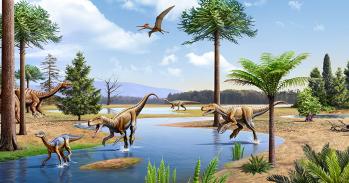
Tonight Cambridge vertebrate palaeontologist Professor Jenny Clack is the subject of BBC Four’s Beautiful Minds series. The programme looks at her contribution to our understanding of early tetrapods - the first four-legged creatures to walk on earth.
Tonight Cambridge vertebrate palaeontologist Professor Jenny Clack is the subject of BBC Four’s Beautiful Minds series. The programme looks at her contribution to our understanding of early tetrapods - the first four-legged creatures to walk on earth.
One of the most intriguing aspects of the fish-tetrapod transition is the development of limbs that made walking on land possible.
Cast your mind back 400 million years. In a misty swamp, a newt-like creature resembling a fish with limbs and covered with glistening skin hauls itself from the teaming waters where it has spent most of its life and moves slowly onto a land surface occupied by fern-like plants and a variety of insects and millipedes. This is how the first steps of our early four-legged ancestors – the earliest members of a wide-ranging group known as tetrapods – are often imagined.
In the great panorama of evolutionary zoology, the transition from water to land is a stage in the development of vertebrate life that has long fascinated palaeontologists. One of the world’s foremost experts on the first tetrapods is Professor Jenny Clack, Curator at Cambridge’s Museum of Zoology. Her career as a curator passionate about public outreach, and her contribution to our understanding of the fish-tetrapod transition, is the subject of tonight’s BBC Four programme Beautiful Minds, a series that celebrates the ways in which contemporary scientists have changed how we think about the world around us.
One of the most intriguing aspects of the fish-tetrapod transition is the development of limbs that made walking on land possible. Over a period of many millions of years the fishy fins that allowed water-living creatures to propel themselves in an aquatic environment gradually developed into legs with finger and toe-like elements. What these limbs looked like as they made the lengthy transition from fins to legs is a tantalising question. It’s also one that has long proved particularly elusive because there has been a huge gap in the fossil record that enables scientists to chart the momentous journey from life in water to life on land.
It is on this transition, and the evolution of weight-bearing limbs, that Professor Clack has focused during a career that has combined curation, and the preparation of specimens for display, with ground-breaking research. Her interest in fossils started when she was a child growing up on the outskirts of Manchester and is something she says she “never grew out of”. It took her into the world of museums, initially as a display technician in the Natural History Department at Birmingham City Museum. In tonight’s programme, which shows her arriving at work on a motorbike, Professor Clack she describes feeling that her arrived at Cambridge from the University of Newcastle, where she took a PhD, was “through the back door” in that her route was somewhat unconventional in academic terms.
What has marked Professor Clack’s career out as exceptional – and what she describes self-effacingly as being the result of lucky finds – is her grasp of the information gained through close examination of fossil records, a skill in which she revealed a facility early on in her career. Most significantly, she and colleagues working on early tetrapods, have discovered that when our early ancestors first stepped on land, rather than flapping and flailing around with fishy fins, they would have already have possessed distinct early limbs with protuberances equivalent to fingers and toes, closely resembling those of their descendants such as newts and salamanders.
Palaeontologists looking at the patterns and processes in the evolution of the limbs that characterised early tetrapods have been frustrated by a lack of fossil evidence for a period known as Romer’s Gap. Named after palaeontologist Dr Alfred Romer, Romer’s Gap is a term first coined in the 1950s to describe an interval that spanned some 30 million years from the end of the Devonian (390 million years ago) to well into the Carboniferous (360 million years ago). Subsequent research has narrowed Romer’s Gap to about 15 million years – but an important part of tetrapod history has remained clouded in uncertainty.
Until recently scientists had just two examples of tetrapods from this 15 million-year period, one from Scotland and the other from Nova Scotia, two now-distant places that were in the same location 350 million years ago. One popular explanation put forward for this scarcity of evidence in the tetrapod fossil record was that there was a shortage in atmospheric oxygen over this substantial period in the history of vertebrate life on earth. Proponents of this view argued that the reason for the scarcity of early tetrapod fossils was straightforward: such animals were very rare as the atmosphere was unsuitable for them.
In 2005 a dramatic discovery in windswept south east Scotland overturned this theory. Palaeontologists found a wealth of tetrapod fossils from this time period from several locations around the area known as the Borders. These finds suggest that such creatures were not rare at all: indeed, they were abundant. Fossilisation of early tetrapods is itself an unusual event, requiring circumstances to be just right, so for the fossils to be discovered at all indicates that there must have been huge numbers of the creatures alive at the time.
Finds amounting to 100 in number and including several new species are hugely significant for palaeontologists seeking to fill in some of the missing links in the chronology and diversity of early terrestrialisation. The fossils themselves were initially located by Stanley Wood, an independent palaeontologist who has spent a lifetime looking for fossil evidence in his native Scotland. Carefully extracted from the rocks, weeds and mud of a Scottish riverbed and shoreline, the fossils were soon being examined by Professor Clack and Dr Timothy Smithson at Cambridge’s Museum of Zoology. They were able to identify the earliest known foot with five toes.
“To have located these fossils is an extraordinary achievement in itself. You really have to know what you are looking for and have an eye tuned into the clues that indicate the possible presence of fossils in amongst the loose material of the riverbed and shoreline in conditions that are wet and slippery. What they have added to our knowledge of early tetrapods in terms of their early evolution into terrestrial habitats is amazing,” said Professor Clack. “We now hope to put together a team of palaeontologists, sedimentologists and stratigraphers from a number of institutions – including Cambridge – who will be able to discover how and when tetrapods became fully terrestrial, and learn more about the environments in which they did so.”
A selection of the Scottish finds is on display at the National Museum of Scotland in Edinburgh until the end of April. It includes fossils of both fishy and newt-like creatures. Some fossils are articulated, showing the bones in positions similar to those they would have had in life, while others consist of scattered disarticulated skeletal elements. Particularly remarkable are elements of what could be a temnospondyl, a group that is widely thought to include the ancestor of modern amphibians. The specimen is almost 15 million years older than any previously found member of this group.
A small display of Early Carboniferous finds from one of the two Scottish sites can be seen by the public at Cambridge's Museum of Zoology from 13 April to 1 October.
Beautiful Minds is on BBC Four at 9pm this evening. Other guests in the series are physicist Professor Andre Geim and evolutionary biologist Professor Richard Dawkins.
This work is licensed under a Creative Commons Licence. If you use this content on your site please link back to this page.





